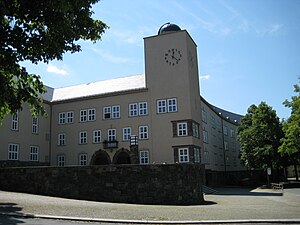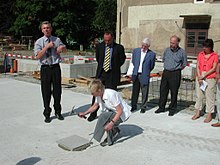Johann-Heinrich-Pestalozzi-Gymnasium
| Johann-Heinrich-Pestalozzi-Gymnasium | |
|---|---|

|
|
| Johann-Heinrich-Pestalozzi-Gymnasium with school tower and school observatory | |
| type of school | high school |
| founding | 1928 |
| address |
Strasse des Friedens 5 |
| place | Rodewisch |
| country | Saxony |
| Country | Germany |
| management | Sven Müller |
| Website | www.pesta-rodewisch.de |
The Johann-Heinrich-Pestalozzi-Gymnasium is a general education high school in Rodewisch in the Free State of Saxony .
history
The construction of the high school
Rodewisch experienced an economic boom at the beginning of the 20th century. The number of students increased and the two previous schools were no longer sufficient to accommodate the number of students. For this reason, the city council decided on June 28, 1927 to build a new school. On August 19, 1927, the 16,000 m² property was acquired by the city administration for a price of 36,000 Reichsmarks . Construction began with the groundbreaking ceremony on July 25, 1928, and the foundation stone was laid on September 10, 1928. With the participation of over 150 stonemasons and bricklayers, the shell of the school could be completed after 17 weeks. Resources from the Elstertal and Zwickau bricks were used for the construction. The topping-out ceremony was celebrated on December 1, 1928. Even before the school building was completed, the school committee decided on March 5, 1929 to name the elementary school “Pestalozzi School”. The interior construction took longer due to financial problems that had their origins in the Great Depression in 1929 and could only be continued in March 1930. The inauguration took place on October 16, 1930.
time of the nationalsocialism
With the seizure of power of Adolf Hitler on 30 January 1933 is also the goal of education in the schools has changed significantly. The goal was no longer the imparting of knowledge and the improvement of intellectual abilities, but the National Socialist education . The girl was prepared for the role of housewife and mother, the boy for life as a soldier. This education was also carried out at the Pestalozzi School. Morning roll calls, the hoisting of the flag, standing at attention in the classroom, and the Führer greeting were part of everyday school life. The Hitler Youth , which was supposed to unite all young people in the Third Reich in one organization, also held events in the Pestalozzi School. An example of this is a promotional event organized by the organization on October 22, 1934 in the school auditorium. The sports field and the gymnasium were also used for various Hitler Youth events. On April 11, 1945, the school was closed because local fighting forced it. After the end of the war, the school provided shelter for refugees and displaced persons .
The school at the end of the war and in the GDR
By Order No. 40 of the Soviet Military Administration , classes were resumed on October 1, 1945. Due to the denazification that took place after the defeat of Nazi Germany, all teachers who belonged to the NSDAP were suspended from school service. So it came about that 9 teachers had to teach 40 school classes. For this reason, lessons could only take place by the hour. There were no teaching aids and no textbooks. In July 1946 10 new teachers came to the school and in the school year 1946/47 there were already 36 teachers at the school. From November 7th to 12th, 1949, the school opened its doors to the public for the first time: the first open day. The school celebrated its 20th anniversary from September 23-25, 1950, with the new school observatory opening at the beginning of the celebrations.
The school observatory
The school observatory was the first newly opened school observatory after the end of the war. It served the astronomy lessons and the associated working group (AG). The observatory was able to secure international recognition by sighting the three artificial earth satellites Sputnik 1 , Sputnik 2 and the Sputnik 3 launcher . The observatory officially became an international satellite observation station in January 1958 (No. 125).
The Pestalozzi School becomes a high school
On September 1, 1953, the Pestalozzi School, which at that time was still a primary school, was converted into a high school. The linguistic profile and the mathematical and scientific profile were introduced. The teaching pool, which the school used intensively, was completed on June 2, 1962. Due to the intensive use, however, the pool was badly worn and the school had to close it. In 1993 the old bathroom was converted into a new gym. An extension on the south wing of the school building, which included a caretaker's apartment, new heating systems and the specialist classrooms for physics, chemistry and biology, was carried out in 1983. On June 12, 1985, the small school museum was set up in the tower of the school building.
The Pestalozzi high school becomes a grammar school
In 1984 there were already language classes that were aiming for higher education entrance qualification and thus the Abitur. However, this only became possible on August 1, 1992, when a three-class high school was set up in the Pestalozzi School building. The school became the Johann-Heinrich-Pestalozzi-Gymnasium and the first graduate class left the school on June 29, 1993. In October 1994 the school set up a modern computer cabinet on the ground floor of the school building. The construction of the Göltzschtalhalle in 1995 enabled the sports teachers to expand their sports lessons and they were no longer dependent on the school's small gym. In 1995 a school partnership with the Sonnenhofschule Auerbach, a school for mentally and physically handicapped children, developed.
Development of the modern high school
In order to adapt the high school to the modern standards of the 21st century, a general renovation was carried out from 2004 to 2005. A new modern extension was built on the north wing of the school building for the subjects of biology, physics and chemistry. It was inaugurated on March 3, 2007 at an open house. With the inauguration of the sports field and the geological educational trail on June 12, 2010, outdoor teaching spaces were created for the students.
The namesake of the school
Johann Heinrich Pestalozzi was chosen as the namesake before the school building was completed in 1930. He was a Swiss educator and studied theology and law. He was born on January 12, 1746 in Zurich and died on February 17, 1827 in Brugg. Before he died, he founded his own educational institute in 1800 and developed the "idea of elementary education" in 1804. This describes the education by developing the powers of the head, the heart and the hand in unison. It thus aimed at the development of intellectual, moral and manual skills.
today
Even today, the grammar school tries to do justice to the name Pestalozzis and his teaching of head, heart and hand. In order to meet these demands, the grammar school has a wide range to support the students and to offer them many different educational opportunities.
2. Foreign language and profiles
In the 6th grade, students have the opportunity to choose a foreign language. The grammar school offers the foreign languages French, Russian and Latin. Later, in the 8th grade, the foreign language Spanish can also be learned as part of the language profile. However, the school not only offers a linguistic profile, but also a scientific and an artistic one. The pupil can decide on a profile and thus orientate himself educationally in a direction that is interesting for him.
11./12. class
In the upper secondary level , too, the student has to choose between various basic and advanced courses and thus focuses on their own education.
Educational trips
Furthermore, the high school supplements its education in its own school building with various projects. In the 7th grade there is an excursion to the ski camp, in the 10th grade a language trip to England. Theater trips and other educational trips also support the curriculum and the education of the students.
internship
The craft should not be missing either. In the 9th grade, all students have a two-week internship in a company of their choice.
School partnership
The school also has a school partnership with the Sonnenhofschule Auerbach and holds an annual sports festival for the mentally and physically disabled children.
All day offer
Furthermore, the school tries to promote the skills and interests of its students with various all-day offers. These all-day offers include the school choir, the theater company, the school circus, the school club, sporting groups such as table tennis or judo, Zumba or model railway construction.
The school tries to educate and inspire its students with competent teachers and a wide range of educational and leisure activities, following the example of Johann Heinrich Pestalozzi. "Because his deep love belonged to the children", as it is written on a wall of the high school.
literature
- Monika Müller: 70 years of the Pestalozzi School , Hofmann printing company, 2000, Johann Heinrich Pestalozzi Grammar School (publisher)
Individual evidence
- ↑ | Building preparation. Retrieved May 28, 2018 .
- ↑ | Construction. Retrieved May 28, 2018 .
- ↑ | 30s. Retrieved May 28, 2018 .
- ↑ | 40s. Retrieved May 28, 2018 .
- ↑ | 50s. Retrieved May 28, 2018 .
- ↑ | In the DDR. Retrieved May 28, 2018 .
- ↑ | 90s. Retrieved May 28, 2018 .
- ↑ | 90s. Retrieved May 28, 2018 .
- ↑ | French. Retrieved May 27, 2018 .
- ↑ | Russian. Retrieved May 27, 2018 .
- ↑ | Latin. Retrieved May 27, 2018 .
- ↑ | Profile lesson. Retrieved May 27, 2018 .
- ↑ | All day offer. Retrieved May 28, 2018 .



